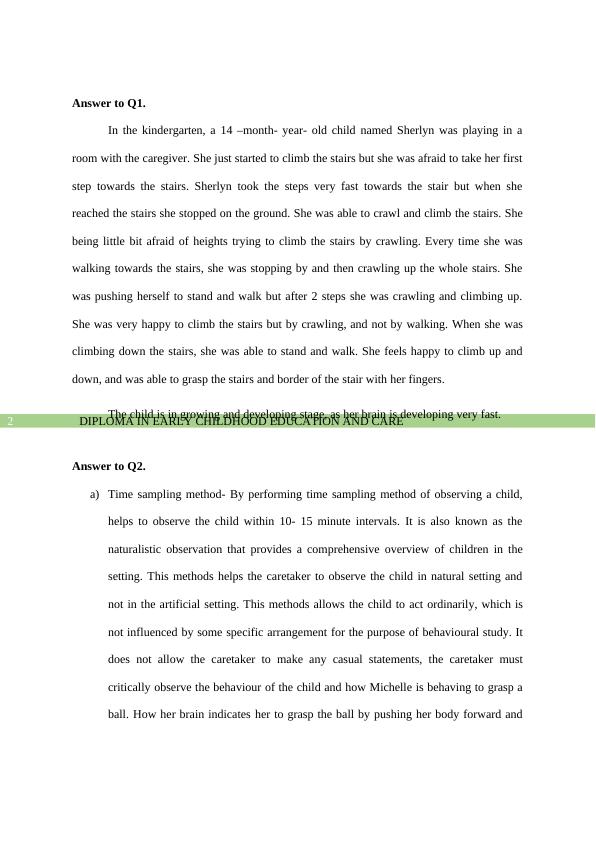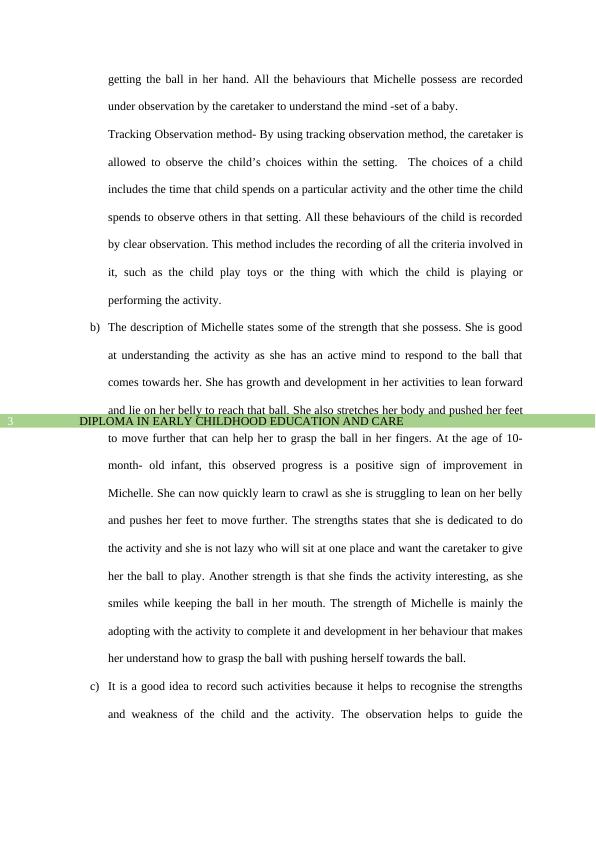EARLY CHILDHOOD EDUCATION AND CARE QUESTION ANSWER 2022
Provide two methods of recording behaviors and explain the importance of recording such activities.
15 Pages2753 Words26 Views
Added on 2022-09-28
EARLY CHILDHOOD EDUCATION AND CARE QUESTION ANSWER 2022
Provide two methods of recording behaviors and explain the importance of recording such activities.
Added on 2022-09-28
ShareRelated Documents
Running head: DIPLOMA IN EARLY CHILDHOOD EDUCATION AND CARE
DIPLOMA IN EARLY CHILDHOOD EDUCATION AND CARE
Name of the student
Name of the university
Author’s note
DIPLOMA IN EARLY CHILDHOOD EDUCATION AND CARE
Name of the student
Name of the university
Author’s note

DIPLOMA IN EARLY CHILDHOOD EDUCATION AND CARE1
Table of Contents
Answer to Q1.............................................................................................................................2
Answer to Q2.............................................................................................................................2
Answer to Q3.............................................................................................................................4
Answer to Q4.............................................................................................................................4
Answer to Q5.............................................................................................................................4
Answer to Q6.............................................................................................................................5
References..................................................................................................................................7
Table of Contents
Answer to Q1.............................................................................................................................2
Answer to Q2.............................................................................................................................2
Answer to Q3.............................................................................................................................4
Answer to Q4.............................................................................................................................4
Answer to Q5.............................................................................................................................4
Answer to Q6.............................................................................................................................5
References..................................................................................................................................7

DIPLOMA IN EARLY CHILDHOOD EDUCATION AND CARE2
Answer to Q1.
In the kindergarten, a 14 –month- year- old child named Sherlyn was playing in a
room with the caregiver. She just started to climb the stairs but she was afraid to take her first
step towards the stairs. Sherlyn took the steps very fast towards the stair but when she
reached the stairs she stopped on the ground. She was able to crawl and climb the stairs. She
being little bit afraid of heights trying to climb the stairs by crawling. Every time she was
walking towards the stairs, she was stopping by and then crawling up the whole stairs. She
was pushing herself to stand and walk but after 2 steps she was crawling and climbing up.
She was very happy to climb the stairs but by crawling, and not by walking. When she was
climbing down the stairs, she was able to stand and walk. She feels happy to climb up and
down, and was able to grasp the stairs and border of the stair with her fingers.
The child is in growing and developing stage, as her brain is developing very fast.
Answer to Q2.
a) Time sampling method- By performing time sampling method of observing a child,
helps to observe the child within 10- 15 minute intervals. It is also known as the
naturalistic observation that provides a comprehensive overview of children in the
setting. This methods helps the caretaker to observe the child in natural setting and
not in the artificial setting. This methods allows the child to act ordinarily, which is
not influenced by some specific arrangement for the purpose of behavioural study. It
does not allow the caretaker to make any casual statements, the caretaker must
critically observe the behaviour of the child and how Michelle is behaving to grasp a
ball. How her brain indicates her to grasp the ball by pushing her body forward and
Answer to Q1.
In the kindergarten, a 14 –month- year- old child named Sherlyn was playing in a
room with the caregiver. She just started to climb the stairs but she was afraid to take her first
step towards the stairs. Sherlyn took the steps very fast towards the stair but when she
reached the stairs she stopped on the ground. She was able to crawl and climb the stairs. She
being little bit afraid of heights trying to climb the stairs by crawling. Every time she was
walking towards the stairs, she was stopping by and then crawling up the whole stairs. She
was pushing herself to stand and walk but after 2 steps she was crawling and climbing up.
She was very happy to climb the stairs but by crawling, and not by walking. When she was
climbing down the stairs, she was able to stand and walk. She feels happy to climb up and
down, and was able to grasp the stairs and border of the stair with her fingers.
The child is in growing and developing stage, as her brain is developing very fast.
Answer to Q2.
a) Time sampling method- By performing time sampling method of observing a child,
helps to observe the child within 10- 15 minute intervals. It is also known as the
naturalistic observation that provides a comprehensive overview of children in the
setting. This methods helps the caretaker to observe the child in natural setting and
not in the artificial setting. This methods allows the child to act ordinarily, which is
not influenced by some specific arrangement for the purpose of behavioural study. It
does not allow the caretaker to make any casual statements, the caretaker must
critically observe the behaviour of the child and how Michelle is behaving to grasp a
ball. How her brain indicates her to grasp the ball by pushing her body forward and

DIPLOMA IN EARLY CHILDHOOD EDUCATION AND CARE3
getting the ball in her hand. All the behaviours that Michelle possess are recorded
under observation by the caretaker to understand the mind -set of a baby.
Tracking Observation method- By using tracking observation method, the caretaker is
allowed to observe the child’s choices within the setting. The choices of a child
includes the time that child spends on a particular activity and the other time the child
spends to observe others in that setting. All these behaviours of the child is recorded
by clear observation. This method includes the recording of all the criteria involved in
it, such as the child play toys or the thing with which the child is playing or
performing the activity.
b) The description of Michelle states some of the strength that she possess. She is good
at understanding the activity as she has an active mind to respond to the ball that
comes towards her. She has growth and development in her activities to lean forward
and lie on her belly to reach that ball. She also stretches her body and pushed her feet
to move further that can help her to grasp the ball in her fingers. At the age of 10-
month- old infant, this observed progress is a positive sign of improvement in
Michelle. She can now quickly learn to crawl as she is struggling to lean on her belly
and pushes her feet to move further. The strengths states that she is dedicated to do
the activity and she is not lazy who will sit at one place and want the caretaker to give
her the ball to play. Another strength is that she finds the activity interesting, as she
smiles while keeping the ball in her mouth. The strength of Michelle is mainly the
adopting with the activity to complete it and development in her behaviour that makes
her understand how to grasp the ball with pushing herself towards the ball.
c) It is a good idea to record such activities because it helps to recognise the strengths
and weakness of the child and the activity. The observation helps to guide the
getting the ball in her hand. All the behaviours that Michelle possess are recorded
under observation by the caretaker to understand the mind -set of a baby.
Tracking Observation method- By using tracking observation method, the caretaker is
allowed to observe the child’s choices within the setting. The choices of a child
includes the time that child spends on a particular activity and the other time the child
spends to observe others in that setting. All these behaviours of the child is recorded
by clear observation. This method includes the recording of all the criteria involved in
it, such as the child play toys or the thing with which the child is playing or
performing the activity.
b) The description of Michelle states some of the strength that she possess. She is good
at understanding the activity as she has an active mind to respond to the ball that
comes towards her. She has growth and development in her activities to lean forward
and lie on her belly to reach that ball. She also stretches her body and pushed her feet
to move further that can help her to grasp the ball in her fingers. At the age of 10-
month- old infant, this observed progress is a positive sign of improvement in
Michelle. She can now quickly learn to crawl as she is struggling to lean on her belly
and pushes her feet to move further. The strengths states that she is dedicated to do
the activity and she is not lazy who will sit at one place and want the caretaker to give
her the ball to play. Another strength is that she finds the activity interesting, as she
smiles while keeping the ball in her mouth. The strength of Michelle is mainly the
adopting with the activity to complete it and development in her behaviour that makes
her understand how to grasp the ball with pushing herself towards the ball.
c) It is a good idea to record such activities because it helps to recognise the strengths
and weakness of the child and the activity. The observation helps to guide the

End of preview
Want to access all the pages? Upload your documents or become a member.
Related Documents
Case study patient: Lydialg...
|2
|461
|273
Observation and Recommendations for Infant Developmentlg...
|5
|744
|91
CHCECE010 Support the holistic development of children in early childhoodlg...
|37
|5871
|116
